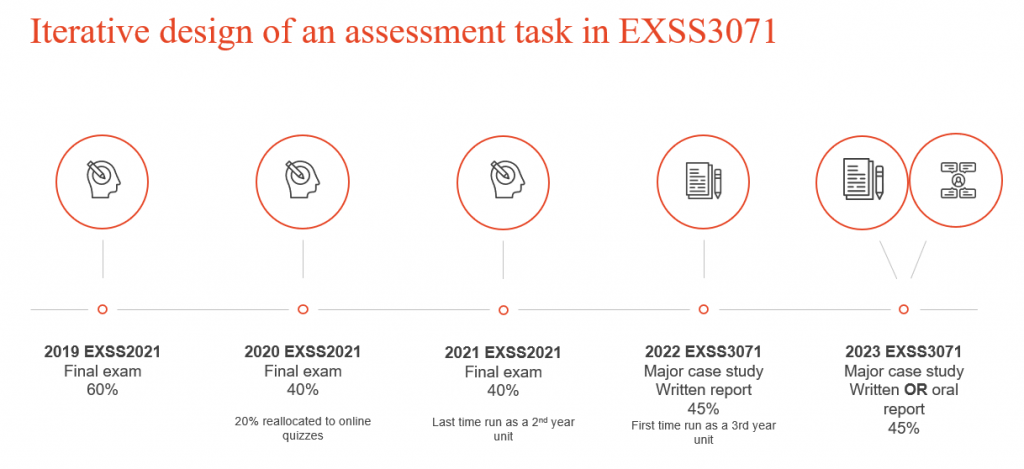This year our monthly UDL Chats continue to host colleagues from around the University, willing to share their stories about using Universal Design for Learning (UDL) as a framework to guide the redesign of more inclusive teaching and learning experiences. These 30 minute chats take place via Zoom on the first Wednesday of each month from 12.30pm to 1.00pm. Listening to each others stories is a great way to learn more about UDL and to see that it is an iterative process that unfolds gradually and does not need to be overwhelming.
In March we were joined by Dr Janelle Gifford from the Faculty of Medicine & Health, who shared her experience rethinking the assessment design in her core unit of study Nutrition for Exercise and Health in response to the growing recognition of the limitations of assessing overall performance and content knowledge through traditional final exams. Her story spans a 4 year period of small incremental changes, reflection and collaboration with students and colleagues. During our 30 minute UDL Chat, Janelle talked to us about the steps she took to shift from an exam to a more authentic and engaging case study report for her cohort of around 80 students.

1. Who are your learners – what does learner variability look like in your cohort?
In 2022 the unit of study Nutrition for Exercise and Health changed from being a 2nd year to a 3rd year core unit for students undertaking either Exercise Physiology or Exercise and Sports Science as part of their Bachelor of Applied Science degrees. This unit has around 80 students, the majority of whom are 18-24. The cohort has a gender mix but skews slightly male (60:40) and includes mature age and international students. These students are in their 3rd of study and are just about to go on to do their two practical placements.
2. What are the barriers to learning that you are trying to address?
In 2020 the assessment schedule included an end of year exam with a weighting of 60%. I was looking for ways to assess students in a more authentic and meaningful way, to remove the reliance on memory and recall and to design a task that would have relevance to the practical placements students would be undertaking. Students had also commented that the weighting of the final exam was “a lot” and had suggested regular quizzes. Barriers associated with academic integrity also started to surface during the COVID pandemic and the shift to online learning.
3. What was your goal?
I wanted to rethink the design of the assessments to:
- better meet the needs of a diverse cohort
- increase challenge and academic rigour for students in their third year, and
- be more relevant to pending practicum and employment.
4. What solutions have you tried in order to remove those barriers?
The first iteration in 2020 involved changing the weighting of the exam from 60% to 40%. This allowed the creation of four online quizzes worth 20% which in turn increased opportunities for students to test their knowledge throughout the semester.
The second iteration began 2021 when I started thinking about replacing the exam with a case study approach. The assessments felt tired and really needed a fresh modern, relevant feel. I had already developed an assessment description based on the Exercise and Sport Science Australia (ESSA) Professional Standards and needed help with finetuning that and developing a rubric.
At this point I started working with Sarah Humphreys, an expert in Universal Design for Learning (UDL) and an Educational Design Manager in Educational Innovation. Working with Sarah I was able to apply a universal design for learning approach to the redesign of the assessment. We spent time looking at the learning outcomes and professional standards so that the purpose was very clear (ENGAGEMENT – Heighten salience of goals and objectives). This clarity gave us more flexibility to think about how students might demonstrate their knowledge and the exam was eventually replaced in 2022 with a major case study report worth 45% coinciding with the first year the unit was taught as a third year unit.
This was accompanied by a new rubric design based on examples inspired by Dr Benjamin Miller, one of the University’s UDL champions. The intent was to design the rubrics so students could use them more strategically as a tool to monitor their own progress. The design incorporated explicit descriptions of the expected learning (ACTION & EXPRESSION – Enhance capacity for monitoring progress) and a renaming and reordering of the competency levels commencing with “Excellent” i.e where all students ideally should be (ENGAGEMENT – Promote expectations and beliefs that optimise motivation).
I am continually evaluating and iterating the assessment design and in semester 1 this year I trialled giving my students choice in how they presented their report – as a written report or as an oral presentation (ACTION & EXPRESSION – Vary the methods for response and navigation) and made this explicit in the Unit of Study outline (see below). This iteration also included a reduced word count, more scaffolding and explicit instruction to support student success.

5. How do you know if these changes have had an impact on your learners and what will you do next?
Semester 1, 2022 I was upfront with students about the changes made to the assessment and the rationale for offering a major case study report instead of an exam. I invited feedback and comments throughout the semester from students, markers and tutors. A Padlet was created for students to post questions about the assessment or to give feedback on it. Students liked this approach because it allowed them to post anonymously and view all of the questions and answers. Students were also invited to be part of a focus group, although only 2 took up this offer. All of the students suggestions have been incorporated in the next iteration of the assessment which includes:
- Areas that needed clarification
- Aspects they found useful and will therefore be retained
- Suggested changes to the allocation of weightings in the rubric
- Suggestions of where to add examples to help clarify the expectations
It is interesting to note that no students took up the option to present their report as an oral presentation this time, however one student did comment that they would have taken up this option if they’d been more organised. For the next iteration, I will continue to offer two modes for the report and request the addition of one tutorial dedicated to supporting both oral and written presentation skills. I can see how these continuing iterations of the assessment are beneficial for all students.
Want to know more about how UDL can help you design for diversity?
- Join Educational Innovation’s UDL Chat on the first Wednesday of each month via Zoom.
- Book a 30 minute UDL Consultation
- Enquire about a longer term project through the Educational Design Accelerator request form.
- Check out these UDL Tips for Assessment developed by CAST (2020).
- See how other University of Sydney colleagues are using UDL to design for diversity.





